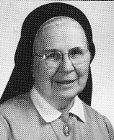
Sister Amata Brachtesende, MM
Born: May 6, 1909
Entered: October 15, 1928
Died: March 19, 1988
Shortly before midnight on March 19, the Feast of St. Joseph, Sister M. Amata Brachtesende gave a last short sigh and passed gently into the arms of God.
In a recent conversation Sister Amata shrugged off the concern expressed about her physical condition and said with shining eyes and that wonderful smile she had, “I’m just so overwhelmed at God’s goodness to me.” In the words of her favorite Psalm (103), she was taking the time to “remember all God’s kindnesses” and the promise to “renew (her) youth like an eagle’s.”
Margaret Ann Brachtesende was born on May 6, 1909 in St. Louis, Missouri. Her father, Henry, who had come to the U.S. from Holland as a child, and her mother, Mary Schomaker Brachtesende, had seven children, 5 girls and 2 boys. After graduation from Grammar School, Margaret studied at night to master several basic and specialized business skills.
In 1928, when she applied for entrance into Maryknoll, she was a fullfledged office worker making $720.00 a year – a pretty good sum for those days. 1988 marks 60 years of commitment to God in service to mission for that enthusiastic group of women who entered the Congregation along with Margaret. She, nor any of the others, had any idea of the challenges, the joys, the relationships, the pain and the growth that would form the warp and woof of their lives over those years, but one thing was sure: The Master Designer would always be at hand to see the pattern through. The future of Sister Mary Amata, as Margaret was named at Reception, was to be a multicolored weaving with a diversity of designs.
After completing her high school requirements at the Venard (Clark’ s Summit, Pennsylvania) and having made her Final Profession in 1934, Sister Amata went on to get a degree in History from Immaculate Heart College in Los Angeles. The following year, 1937, her dreams for an overseas assignment came true when her name was called for Hong Kong.
A month earlier open warfare between China and Japan had erupted and would cut short Sister Amata’s time in her first mission. Kowloon fell on December 12, 1941 and on Christmas Day while she was on volunteer duty to help care for the many wounded in Queen Mary’s Hospital, she stood by a window and watched a white flag raised on the fortified hill across the way that signaled the surrender of Hong Kong. Sister spent several months in the Stanley Internment Camp before repatriation and return to the U.S. in August, 1942.
During the next period of her missionary life Sister Amata taught school for 14 years in Hawaii, 8 years in the Philippines and 3 years in Chicago Chinatown. Her joyful personality, quick wit and sensitivity to others endeared her to students, parents and teachers. Sister’s speech and writings were punctuated with delightfully apt metaphors and though she described herself as “emotional and impulsive”, her sincerity was the constant quality that came through. Her relationship to God was one of simplicity, profound trust and full of wonder. The example of her life taught more than her religion classes, though they were appreciated, too.
In 1972, Sister returned to the Center where she contributed her skills in different supportive services and taught English to Vietnamese seminarians. From 1978 to 1985 she engaged in pastoral ministry in Terryville, Connecticut.
The years following Vatican II with the changes and tensions experienced in the Church and particularly in religious life were challenging for everyone. Sister Amata expressed her concern about some of these changes and the effect they might have on the traditional values that drew her to religious life and to Maryknoll. However difficult that transition period was, Sister respected others though their positions varied, continued to evidence her own convictions through positive, concrete examples and came to an inner peace by opening herself, as she stated, to “the thrill of getting to know the real Maryknoll again.”
These last years here at the Center were spent as a part-time member of the Library staff and full time good neighbor to those who needed help, taking on extra cleaning and cooking chores, visiting the sick and doing laundry for the disabled. Sister enjoyed being with people – she loved to perform and hated to miss a party – and this last Christmas was a special joy to her. She had great success as a volunteer Promoter and one of her Church talks last summer brought in by far the biggest collection for the year.
When an old friend of Sister Amata was asked what she thought was important to remember about her, this was the reply: “What I remember from all my years with her was her companionship and her sense of fun. She was a good person to take a walk with, in the evenings after a long and often laborious day. But maybe that’s not noteworthy.” Perhaps, ultimately, it is most newsworthy, for it reveals more than any of accomplishments.
Let us remember and give thanks for Sister Amata and rejoice with her as she walks now with the God that was – and is – her constant companion.
We express our sympathy to Sister Amata’s family and friends, as well as to those many other persons whose lives she touched. We welcome all of you who have come to celebrate God’s great goodness in this Eucharistic Liturgy of the Resurrection.
